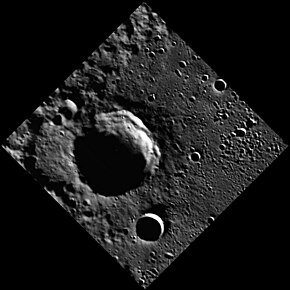
Sofonisba Anguissola, also known as Sophonisba Angussola or Sophonisba Anguisciola, was an Italian Renaissance painter born in Cremona to a relatively poor noble family. She received a well-rounded education that included the fine arts, and her apprenticeship with local painters set a precedent for women to be accepted as students of art. As a young woman, Anguissola traveled to Rome where she was introduced to Michelangelo, who immediately recognized her talent, and to Milan, where she painted the Duke of Alba. The Spanish queen, Elizabeth of Valois, was a keen amateur painter and in 1559 Anguissola was recruited to go to Madrid as her tutor, with the rank of lady-in-waiting. She later became an official court painter to the king, Philip II, and adapted her style to the more formal requirements of official portraits for the Spanish court. After the queen's death, Philip helped arrange an aristocratic marriage for her. She moved to Sicily, and later Pisa and Genoa, where she continued to practice as a leading portrait painter.

Dawson is a lunar impact crater that lies on the southern hemisphere on the far side of the Moon. It lies across a crater triplet: the southeast rim is intruding into the crater Alekhin; the northwest rim also intrudes into the larger satellite crater Dawson V, and the northeast rim is attached to the comparably sized Dawson D. To the south of this formation is the large crater Zeeman. West of Dawson is the crater Crommelin, and to the north lies Fizeau.

Fabry is a large lunar impact crater of the form termed a walled plain. It is located on the far side of the Moon, just beyond the northeastern limb. Parts of this area are sometimes brought into view by the effects of libration, but the terrain is seen from the edge and so not much in the way of detail can be observed.
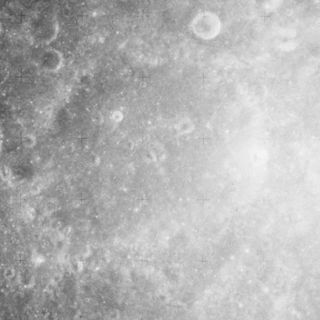
Buisson is a lunar impact crater that is located on the far side of the Moon. It is named after the French physicist Henri Buisson. Nearly attached to the southeast rim is the crater Vesalius. To the southwest is Einthoven. The rim of this crater is somewhat worn, and is lowest in the north. There is a low central ridge across the midpoint.

Fermi is a large lunar impact crater of the category named a walled plain. It was named after Italian-American physicist and Nobel laureate Enrico Fermi. It lies on the far side of the Moon and can not be viewed from the Earth. Thus this feature must be viewed from an orbiting spacecraft.

Chebyshev is a large lunar impact crater that lies in the southern hemisphere on the far side of the Moon. The somewhat smaller crater Langmuir is intruding into the east-southeastern rim of Chebyshev, forming a chain of large craters with Brouwer on Langmuir's eastern rim.

Chrétien is a lunar impact crater that is located in the southern hemisphere on the far side of the Moon from the Earth. It lies due south of the Mare Ingenii, one of the few maria on the Moon's far side. The crater lies in the midpoint between the craters Garavito to the west-southwest and Oresme to the east-northeast, both of these being somewhat smaller than Chrétien.

Holden is a 140 km wide crater situated within the Margaritifer Sinus quadrangle (MC-19) region of the planet Mars, located with the southern highlands. It is named after American astronomer Edward Singleton Holden. It is part of the Uzboi-Landon-Morava (ULM) system.

Matisse is an impact crater on the southern hemisphere of Mercury. Matisse takes its name from the French artist Henri Matisse, and it was named by the IAU in 1976.
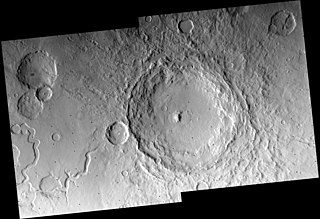
Cerulli is a crater in the Ismenius Lacus quadrangle on Mars with a diameter of 130 km. It lies in the northern hemisphere south of the very large crater Lyot. It is named after Vincenzo Cerulli, an Italian astronomer (1859–1927).

Eddie is a crater in the Elysium quadrangle of Mars. It is 89 km in diameter and was named after Lindsay Eddie, a South African astronomer (1845–1913).

Endeavour is an impact crater located in the Meridiani Planum extraterrestrial plain within the Margaritifer Sinus quadrangle (MC-19) region of the planet Mars. Endeavour is about 22 kilometers (14 mi) in diameter. Using Mars Reconnaissance Orbiter data, phyllosilicate-bearing outcrops have been detected along its rim. These minerals may have formed under wet conditions in a low-acidic environment during the early history of Mars. There are raised rim segments to the north, east, and southwest. The rim has become worn, rounded and degraded, with infilling of plains material in a manner similar to the Victoria crater.

Puńsk is an impact crater on Mars, located in the Oxia Palus quadrangle at 20.8° N and 41.2° W. It measures 11.6 kilometers in diameter and was named after the village of Puńsk in Poland.
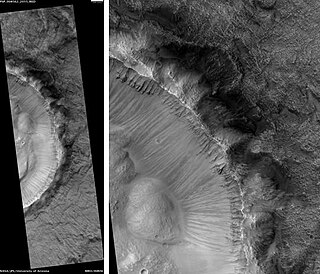
Grindavik is an impact crater in the Oxia Palus quadrangle of Mars, located at 25.39° North and 39.07° West. It is 12 km (7.5 mi) in diameter and was named after Grindavík, a town in Iceland. Impact craters generally have a rim with ejecta around them, in contrast volcanic craters usually do not have a rim or ejecta deposits. As craters get larger they usually have a central peak. The peak is caused by a rebound of the crater floor following the impact.

Derain is a crater on Mercury named after André Derain, a French artist, painter, sculptor and co-founder of Fauvism with Henri Matisse. It has uncommonly dark material within and surrounding the crater. The material is darker than the neighboring terrain such that this crater is easily identified even in a distant global image of Mercury. The dark halo may be material with a mineralogical composition different from the majority of Mercury's visible surface. Craters with similar dark material on or near their rims were seen on the floor of the Caloris basin during MESSENGER’s first flyby.
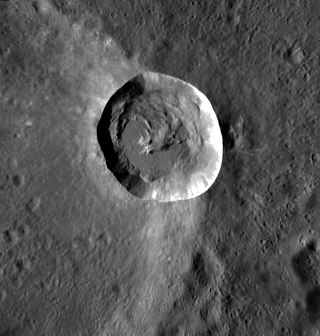
Mena is a crater in the Beethoven quadrangle on Mercury. Its name was adopted by the International Astronomical Union in 1976. Mena is named for the Spanish poet Juan de Mena, who lived from 1411 to 1456.

Gledhill is an impact crater in the Hellas quadrangle of Mars, located at 53.2°S latitude and 87.1°E longitude. It is 78.5 km in diameter. It was named after British astronomer Joseph Gledhill, and the name was approved in 1973 by the International Astronomical Union (IAU) Working Group for Planetary System Nomenclature (WGPSN).
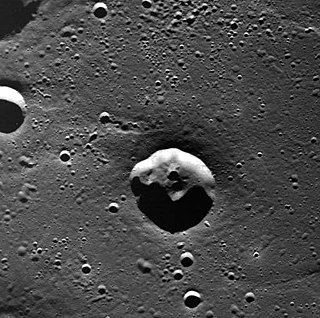
Anyte is a crater on Mercury. It has a diameter of 20.92 kilometres. Its name was adopted by the International Astronomical Union (IAU) on August 4, 2017. Anyte is named for the Greek poet Anyte of Tegea.

Henri is a crater on Mercury. It has a diameter of 163.8 kilometres. Its name was adopted by the International Astronomical Union (IAU) on April 24, 2012. Henri is named for American painter Robert Henri.
